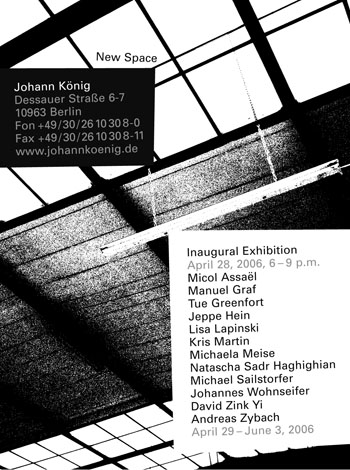Inaugural Exhibition
dal 27/4/2006 al 2/6/2006
Segnalato da
Micol Assael
Manuel Graf
Tue Greenfort
Jeppe Hein
Lisa Lapinski
Kris Martin
Michaela Meise
Natascha Sadr Haghighian
Michael Sailstorfer
Johannes Wohnseifer
David Zink Yi
Andreas Zybach
27/4/2006
Inaugural Exhibition
Johann Konig, Berlin
The new location is a 5.800 ft. post industrial hall close to Potsdamer Platz. The exhibition features works by Micol Assael, Manuel Graf, Tue Greenfort, Jeppe Hein, Lisa Lapinski, Kris Martin, Michaela Meise, Natascha Sadr Haghighian, Michael Sailstorfer, Johannes Wohnseifer, David Zink Yi, and Andreas Zybach.

Inaugural exhibition
Johann Konig, Berlin opened in May 2002 at Rosa Luxemburg Platz in Berlin. The 850 ft. groundfloor space was located in the Polzig building, which also hosts the Kino Babylon. It is close to Alexanderplatz, in the center of east Berlin and opposite of the Volksbuhne.
In april 2006 Johann Konig, Berlin is going to move to its new location, a 5.800 ft. post industrial hall close to Potsdamer Platz, right in the middle of Berlin.
The new gallery is surrounded by the Martin Gropius Bau, the Neue Nationalgalerie and the gallery building in Zimmerstrabe. The gallery is managed by Kirsa Geiser and Johann Konig. They have formed a unique program of emerging and mid-career artists. The gallery is not media specific and has exhibited audio works, video, painting, works on paper, photography, performance, installation and sculpture since its opening.
WWW.28.-30.April2006berlin.de
As last year Johann Konig, Berlin is participating in the gallery weekend 28.-30. APRIL 2006 BERLIN. On this occasion a group show will be organised which is going to include all gallery artist. Major works of all artists will build the core of the exhibtion.
Program:
The gallery is managed by Kirsa Geiser and Johann Konig. They have formed a unique program of emerging and mid-career artists. The gallery is not media specific and has exhibited audio works, video, painting, works on paper, photography, performance, installation and sculpture since its opening.
The gallery represents the following artists: Micol Assael, Manuel Graf, Tue Greenfort, Jeppe Hein, Lisa Lapinski, Kris Martin, Michaela Meise, Natascha Sadr Haghighian, Michael Sailstorfer, Johannes Wohnseifer, David Zink Yi, and Andreas Zybach.
The gallery furthermore shows occasionally historical positions, such as Oyvind Fahlstrom, William Copley, and Manfred Kuttner. The artists represented have been participated in major groupshows such as Manifesta and in several biennales in Berlin, Sydney, Moscow, New York and, in the Venice Biennale. Numerous publications and monographs are available on most gallery artists. The gallery is participating in several art fairs, such as The Armory Show, Frieze Art Fair, Art Basel Miami Beach and for the first time now at Art Basel.
Architecture:
“If man only had a material existence, like a piece of wood or stone, this existence could be protected by material form that hold it tight, just like a jewel in a box. But our existence, that manifests itself in a spontaneous movement, needs a protection that provides enough space for that movement".
(Dom H. Van Der Laan, “The Architectural Space", I.5)
A bare industrial hangar, emptied of its purpose of producing, storing and removing. It is a space of transition.
This reading was at the beginning of converting an old industrial warehouse into an art gallery
The gallery arrives at its dimensions by balancing its relationship with the rational structure of the warehouse. It attempts to engage with the very quality of the hangar, with an acknowledgment of the implicit balance between the pre-existing elements of the site and the new defined rooms of the gallery.
These rooms support diverse functions from meeting room, sanitary, kitchen, storage and the exhibition spaces. The rooms act as instruments showing art embedded within a logical organization. Instead of lotting out the hangar, the alternation between the specific rooms and the hangar is everlasting and present. Every room is defined by the natural elements, the structure of the hangar or both.
Two different exhibition rooms are positioned in direct relation to the upper (natural) light. Neon lightening takes over the rational structure of the hangar by following the roofbeams and is a weaving element throughout the spaces. The neon lightening represents both the hangar and the interventions
An architecture for art may be a contradictio in terminis. Architecture is about making choices of disposition, proportion, dimensions, material and functions, letting loose all other possibilities at a certain point.
But this project is not about that kind of contradiction.
As an artist mentioned on the site:
’A good gallery space should maximize possibilities for all spontaneous movements of different kinds of artists... and their audience. The use of these architectural restrictions could generate different situations according to an artwork and the visitor.’
This particular context, of the hangar, excludes an object - architecture. The architectural response is about transition of art and audience. This intention of this project is not about achieving the originality of a manifesto, but rather an architectural attitude of tenderness and precision, more or less unchanged in the course of time.
The old is old, the new is new, and other possibilities still lie in all future interventions. Including the art that is to come. (April, 2006 - Wim Goes, Anne Konig)
Opening Reception April 28, 6 - 9 p.m.
Johann Koenig, Berlin
Dessauerstr. 6-7 - Berlin
The gallery is located in Kreuzberg, former West Berlin. It is close to: Neue Nationalgalerie (5 min), Martin Gropius Bau (1 min), Galerien Zimmerstrabe (5 min), Hebbel am Ufer (10 min), Gemaldegalerie (5 min), Philharmonie (4 min), Museumsinsel (15 min), Haus der Kulturen der Welt (15 min), Checkpoint Charlie, Sony Center, Staatsbibliothek etc. (2 min)



